Unit 6: Africa, 1100–1980 CE
Contextualization of African Art
African art has a long and rich history that dates back to prehistoric times.
The continent's diverse cultures and civilizations have produced a wide range of artistic traditions, including sculpture, painting, textiles, and performance art.
African art has been influenced by a variety of factors, including religion, politics, and social customs.
The arrival of European colonizers in the 15th century had a significant impact on African art, as it led to the introduction of new materials and techniques, as well as the exportation of African art to Europe.
In the 20th century, African art became increasingly recognized as a valuable and important cultural heritage, leading to the establishment of museums and galleries dedicated to African art around the world.
Architecture of African Art
Mud and clay are the most common building materials used in African architecture.
African architecture is known for its use of organic shapes and materials, such as thatched roofs and woven walls.
African architecture is often designed to blend in with the surrounding landscape and environment.
African architecture is often communal, with buildings serving multiple purposes and being used by multiple families or groups.
African architecture often incorporates symbolic elements, such as the use of certain colors or patterns to represent specific ideas or beliefs.
Sculptures of African Art
African sculptures are known for their expressive and abstract forms.
They are often made from wood, metal, or clay.
Sculptures are used for various purposes such as religious rituals, social status, and storytelling.
African sculptures are characterized by their stylized features, exaggerated proportions, and intricate details.
They often depict human figures, animals, and mythical creatures.
Sculptures are created by skilled artisans who pass down their techniques through generations.
African sculptures have influenced modern art movements such as cubism and expressionism.
They are highly valued by collectors and museums around the world.
Some famous examples of African sculptures include the Benin Bronzes, the Ife Head, and the Dogon Masks.
Cultural Context of African Art
African art is deeply rooted in the cultural context of the continent.
It reflects the diverse traditions, beliefs, and customs of the people who created it.
African art is often functional, serving a specific purpose within the community, such as religious or ceremonial objects.
It is also characterized by its use of symbolism and abstraction, which convey important cultural messages.
African art has influenced many modern artists and continues to be an important part of the continent's cultural heritage.
Materials, Processes, and Techniques of African Art
Materials
African art is made from a wide range of materials including wood, metal, ivory, clay, stone, and textiles.
Wood is the most commonly used material in African art due to its abundance and ease of carving.
Metal is used for casting sculptures and creating intricate jewelry.
Ivory is used for carving small figurines and decorative objects.
Clay is used for creating pottery and sculptures.
Textiles are used for creating clothing, blankets, and other decorative items.
Processes/Techniques
African art is created using a variety of processes including carving, casting, weaving, and painting.
Carving is the most common process used in African art and involves using a chisel or knife to shape wood, ivory, or stone.
Casting is used to create metal sculptures and involves pouring molten metal into a mold.
Weaving is used to create textiles and involves interlacing threads or fibers.
Painting is used to decorate sculptures, pottery, and textiles.
African Artworks
➼ Great Zimbabwe
Details
Shona peoples (Southeastern Zimbabwe)
c. 1000–1400
coursed granite blocks
Found in Zimbabwe
Form
Walls: 800 feet long, 32 feet tall; 17 feet thick at base.
Walls slope inward toward the top; made of exfoliated granite blocks.
Function
Zimbabwe was a prosperous trading center and royal complex; items from as far away as Persia and China have been found.
Stone enclosure was probably a royal residence.
Context
Zimbabwe derives from a Shona term meaning “venerated houses” or “houses of stone.”
Internal and external passageways are tightly bounded, narrow, and long; occupants are forced to walk in single file, paralleling experiences in the African bush.
The conical tower is modeled on traditional shapes of grain silos; control over food symbolized wealth, power, and royal largesse.
The tower resembles a granary and represented a good harvest and prosperity; grain gathered, stored, and dispensed as a symbol of royal power.
Abandoned in the fifteenth century probably because the surrounding area could no longer supply food and there was extensive deforestation.
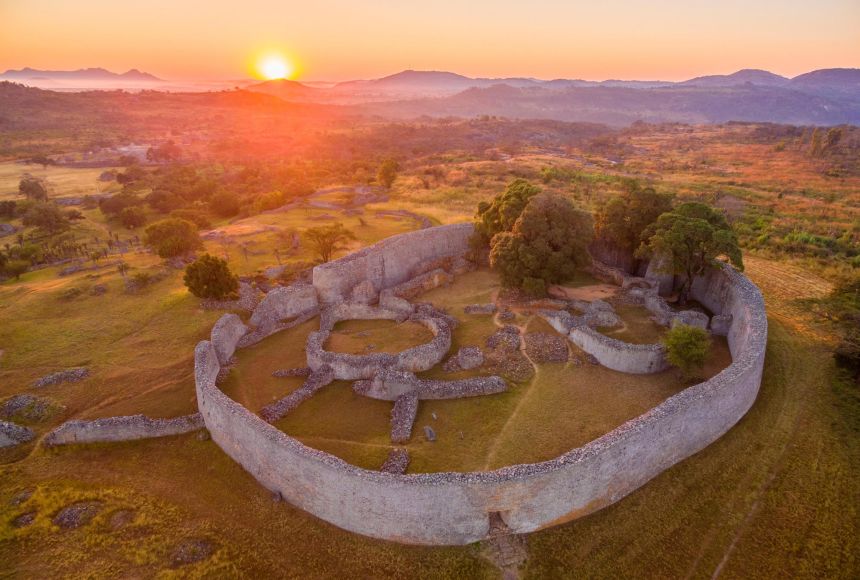
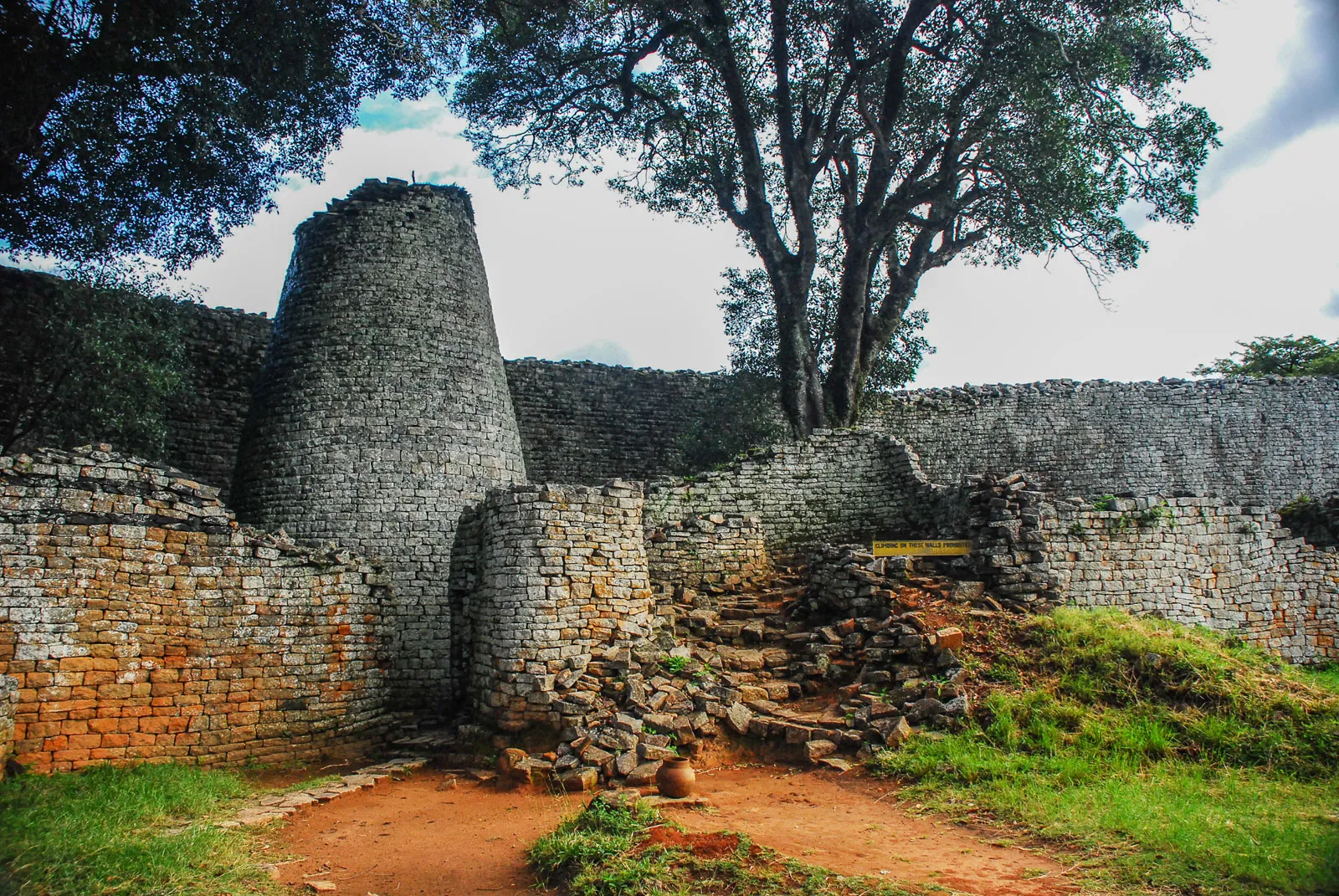
➼ Great Mosque of Djenné
Details
founded c. 1200, rebuilt 1906–1907
An adobe
Found in Djenné, Mali
Form
Three tall towers; center tower is a mihrab.
Vertical fluting drains water off the surfaces quickly.
Materials
Made of adobe, a baked mixture of clay and straw; adobe helps maintain cooler temperatures.
Torons: wooden beams projecting from walls.
Wooden beams act as in-place ladders for the maintenance of the building.
Function: Largest mud-brick mosque in the world.
Content
Crowning ornaments have ostrich eggs, symbols of fertility and purity.
Roof has several holes with terra cotta lids to circulate air into the main room.
Context
Inhabited since 250 B.C.E., Djenné became a market center and an important link in the trans-Saharan gold trade.
Two thousand traditional houses survive, built on small hills to protect against seasonal floods.
Once a year there is a community activity to repair the mosque called Crepissago de la Grand Mosquée.
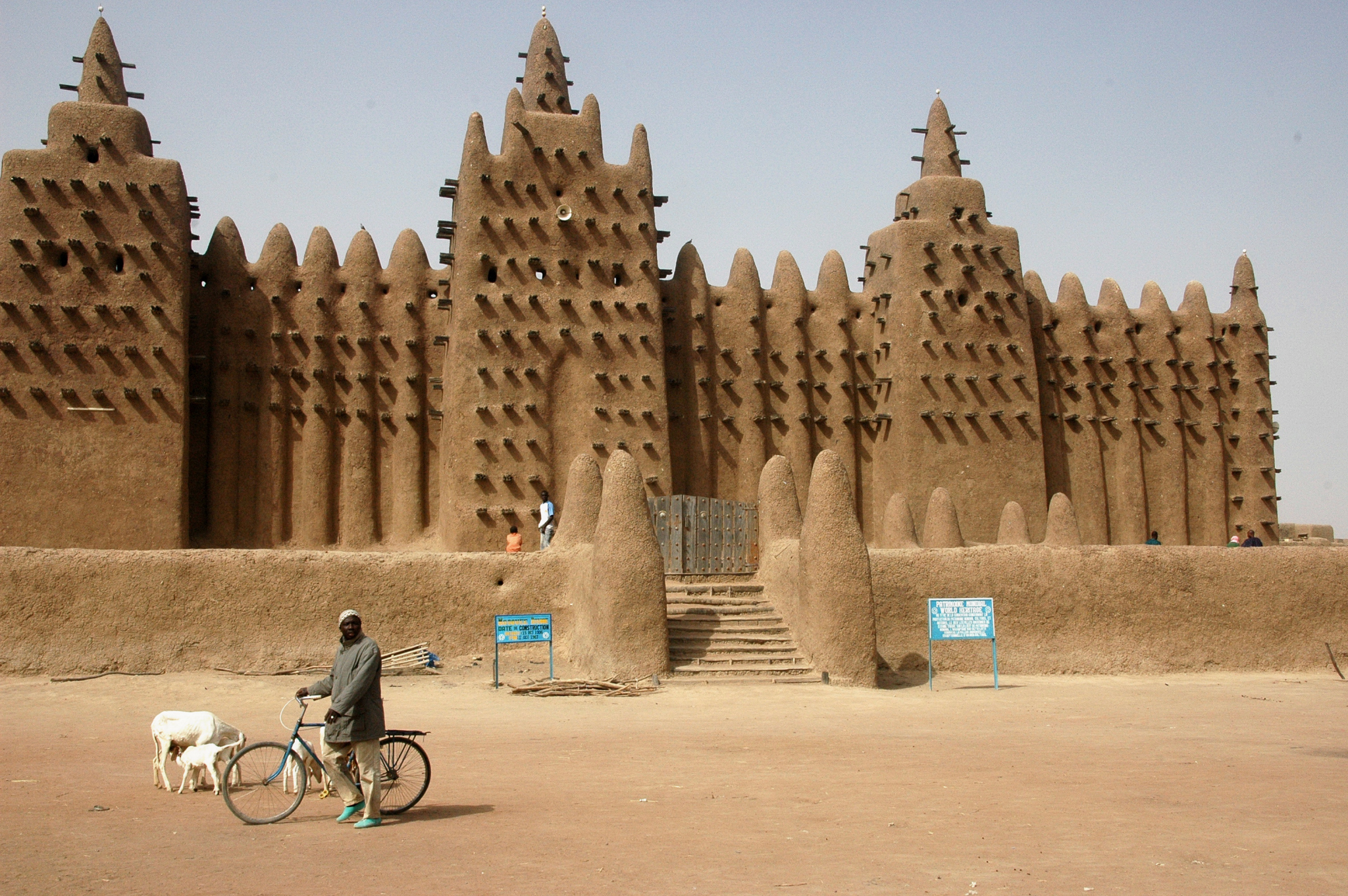
➼ Benin Wall Plaque
Details
from Oba’s palace, Edo peoples, Kingdom of Benin (Nigeria)
16th century
cast brass
Found in Metropolitan Museum of Art, New York
Materials
One of 900 brass plaques produced, each between 16 and 18 inches.
Metal products are rare in Africa, making these objects extremely valuable.
There was an active trade with the Portuguese for brass.
Function
It decorated the walls of the royal palace in Benin.
It was part of a sprawling palace complex; wooden pillars covered with brass plaques.
Context: Shows aspects of court life in the Benin culture
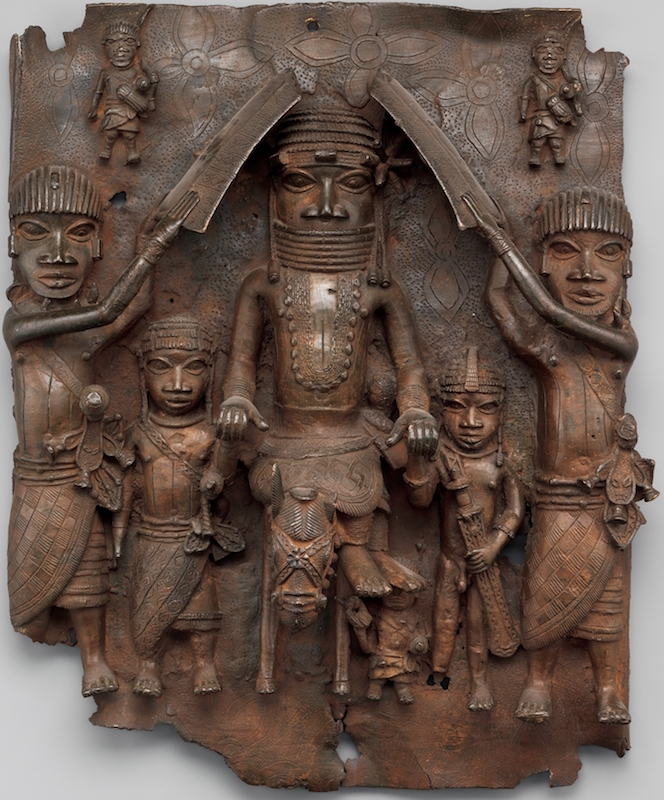
➼ Golden Stool of Ashanti (Sika Dwa Kofi)
Details
Ashanti peoples (south central Ghana)
c. 1700
gold over wood, and cast gold attachments
location unknown
Form
Entire surface inlaid with gold.
Bells hang from the side to warn the king of danger.
Replicas often used in ceremonies, but each replica is different.
Function
Symbol of the Ashanti nation, in Ghana.
Contains the soul of the nation.
Never actually used as a stool; never allowed to touch the ground; it is placed on a stool of its own.
According to Ashanti tradition, it was brought down from heaven by a priest and fell into the lap of the Ashanti king, Osei Tutu.
It became the repository of the spirit of the nation; it is the symbol of the mystical bond among all Ashanti.
Context
A new king is raised over the stool.
The stool is carried to the king on a pillow; he alone is allowed to touch it.
Taken out on special occasions.
War of the Golden Stool: March–September 1900:
Conflict over British sovereignty in Ghana (formerly the Gold Coast).
A British representative who tried to sit on the stool caused an uproar and a subsequent rebellion.
The war ended with British annexation and Ashanti de facto independence.
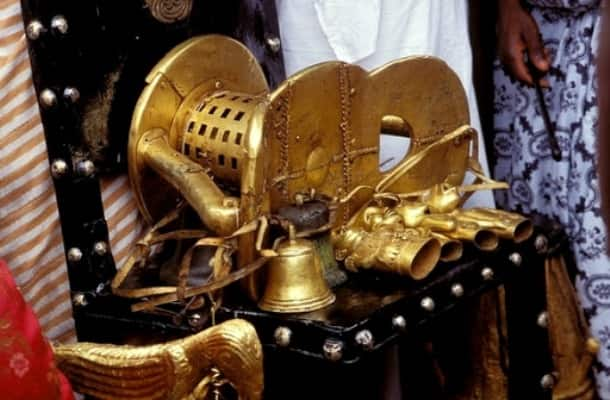
➼ Ndop (portrait figure) of King Mishe miShyaang maMbul
Details
Kuba peoples, Democratic Republic of the Congo
1760–1780
Wood
Found in Brooklyn Museum, Brooklyn, New York
Form
Characteristics of a ndop:
Cross-legged pose.
Sits on a base.
Epicene body.
Face seems uninvolved, above mortal affairs.
A peace knife in his left hand.
Royal regalia: bracelets, arm bands, belts, headdress.
Function
Ndop sculptures are commemorative portraits of Kuba rulers, presented in an ideal state.
Not an actual representation of a deceased king but of his spirit.
Made after the death of the king.
Context
Each king is commemorated by symbols on the base of the figure; this king has a sword in his left hand in a nonaggressive pose, handle facing out.
One of the earliest existing African wood sculptures; oldest ndop in existence.
Rubbed with oil to protect it from insects.
Acted as a surrogate for the king in his absence.
Kept in the king’s shrine with other works called a set of “royal charms.”
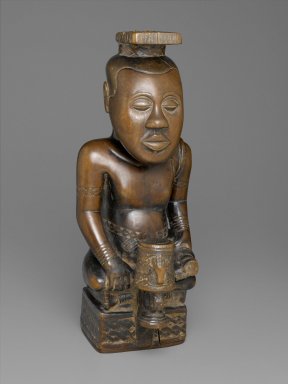
➼ Power Figure (Nkisi n’kondi)
Details
Kongo peoples, Democratic Republic of the Congo
c. late 19th century
wood and metal
Found in Metropolitan Museum of Art, New York
Form
Alert pose.
Rigid frontality.
Arms akimbo, in an aggressive stance.
Wears a headdress worn by chiefs or priests.
Nails are pounded into the figure.
Function and Context
Spirits are embedded in the images.
Spirits can be called upon to bless or harm others, cause death or give life.
In order to prod the image into action, nails and blades are often inserted into the work or removed from it.
Medical properties are inserted into the body cavity, thought to be a person’s life or soul.
The figure has a role as a witness and enforcer of community affairs.
The figure also cautions people on the consequences of actions contrary to community norms.
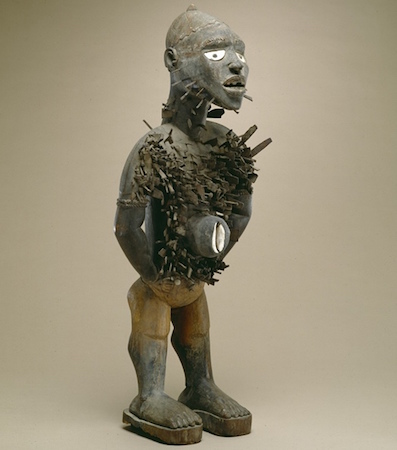
➼ Portrait Mask (Mblo) of Moya Yanso
Details
Baule peoples (Côte d’Ivoire)
early 20th century
wood and pigment
Form
Broad forehead, pronounced downcast eye sockets, column-shaped nose: features associated with intellect and respect.
Quiet faces; introspective look; peaceful face; meditative; eyebrows in an arch.
Function
Presented at Mblo performances in which an individual is honored with ritual dances; tributes are performed in his or her honor.
The dancer who wears the mask and wears the clothes of the person for the performance is accompanied by the actual person in the performance.
The honoree receives a mask—an artistic double of the person—as a gift.
Context
The masks are commissioned by a group of admirers, not by an individual; this one was made by the artist Owie Kimou.
The masks are an idealized representation of a real person.
This is the idealized representation of Moya Yanso.
From the Ivory Coast.
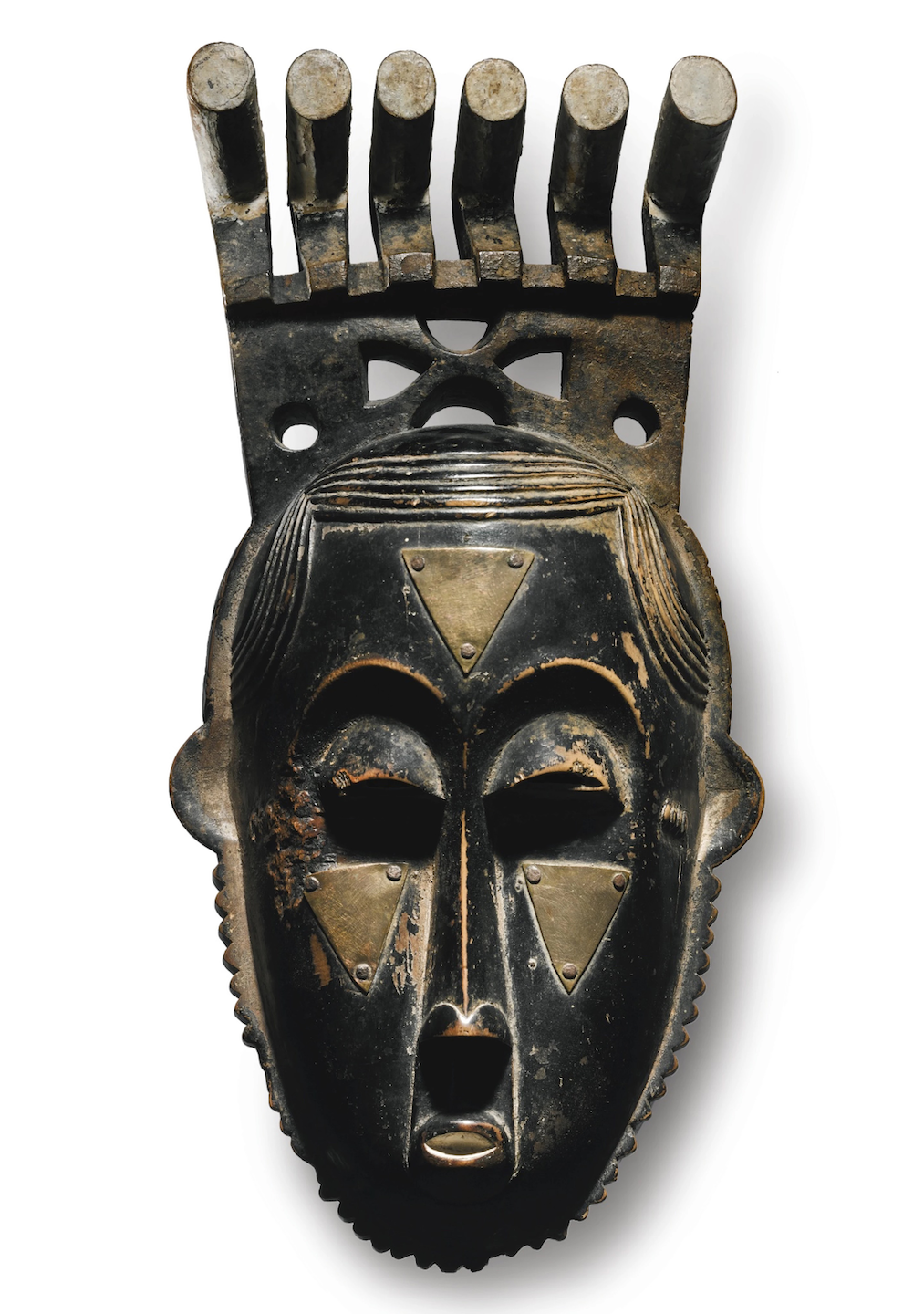
➼ Female (Pwo) Mask
Details
Chokwe peoples, Democratic Republic of the Congo
late 19th to early 20th century
wood, fiber, pigment, and metal
Found in National Museum of African Art, Washington, D.C.
Form
Characteristics:
Enlarged eye sockets.
Pushed-in chin.
Slender nose.
High forehead.
Balanced features.
Almost-closed eyes.
Content
Marks around the eyes may suggest tears; scarification marks including cosmogram on forehead.
White powder around the eyes connects the figure to a spiritual realm.
Function
These are female masks used by men in ritual dances.
Male dancers are covered with their identities masked; they are dressed as women with braided hair.
During the ritual, men move like women.
Depicts female ancestors.
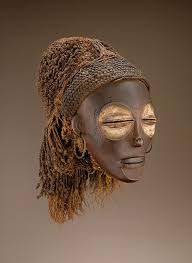
➼ Mende Bundu Mask
Details
Sande society, Mende peoples (West African forests of Sierra Leone and Liberia)
19th to early 20th century
wood, cloth, and fiber
A private collection
Form
Idealized female beauty, both physically and morally:
Elaborate hairstyle symbolizes wealth; worn by women of status.
High forehead indicates wisdom.
Small eyes in the shape of slits: she should be demure.
Tight-lipped mouth, symbolizing secrets not revealed.
Small ears: avoids gossip.
Rings around the neck symbolize concentric waves from which the water spirit, Sowei, breaks through the surface; also symbolizes the fat associated with a pregnant body.
Small horizontal features.
Function
Used for initiation rites to adulthood.
Used by the elder women of the Sande society, a group of women who prepare girls for adulthood and their role in society.
Mask rests on woman’s head; head is not placed inside the mask.
Mask is coated with palm oil for a lustrous effect; it has a shiny black surface.
Black color symbolizes water, coolness, and humanity.
Context
Only African wooden masks that are worn by women.
Costumed women wear a black gown made of raffia that hides the body.
Costumed as a Sowei, the female water spirit.
Female ancestor spirits.
Symbolic of the chrysalis of a butterfly; young woman entering puberty.
Individuality of each mask is stressed.
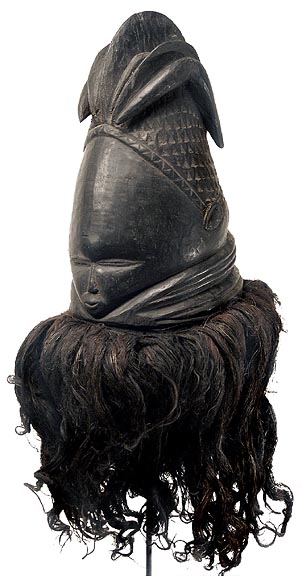
➼ Ikenga (Shrine Figure)
Details
Igbo peoples (Nigeria)
c. 19th to 20th century
Wood
Found in Brooklyn Museum, Brooklyn, New York
Function and Content
Ikenga means “strong right arm” and thus physical prowess.
It honors the right hand, which holds tools or weapons, makes sacrifices, conducts rituals, and alerts to speak at public forums.
Ikenga embraces traditional masculine associations of strength and potency.
Often a mix of human, animal, and abstract forms.
Carved from hardwoods, considered masculine.
It tells of the owner’s morality, prosperity, achievements, genealogy, and social rank.
Context
Enormous horns symbolize power.
Requires blessings before use; consecrated with offerings before kinsmen.
As the man achieves more success, he might commission a more elaborate version.
It is maintained in the man’s home and is destroyed when the owner dies; another can reuse it if not destroyed.

➼ Lukasa (Memory Board)
Details
Mbudye Society, Luba peoples, Democratic Republic of the Congo
c. 19th to 20th century
wood, beads, and metal
Found in Brooklyn Museum, Brooklyn, New York
Form
Carved from wood in an hourglass shape and adorned with beads, shells, or metal.
Back, expressed by Luba people as the “outside,” resembles the shell of a turtle.
Function
Court historian who serves as reader of the memory board holds the lukasa in his left hand and gently touches the beads that he will discuss with his right index finger.
Ability to read the board is limited to a few people.
Memory board helps the user remember key elements in a story; for example:
Court ceremonies.
Migrations.
Heroes.
Kinship.
Genealogy.
Lists of kings.
Context
Each board’s design is unique and represents the divine revelations of a spirit medium expressed in sculptural form.
Memory boards are controlled by the Mbudye, a council of men and women who interpret the political and historical aspects of Luba society.
Zoomorphic elements represented by the turtle, an animal that lives on both land and water; the dual nature of the turtle is a metaphor for the Luba people’s political organization as founded by two distinctly opposed embodiments of power: Kongolo Mwamba, avatar of all excess and tyranny, and Mbidi Kiluwe, sophisticated cultural hero who introduced royal culture to the Luba people.
Reading example:
One colored bead can stand for an individual.
Large beads surrounded by smaller beads can signify a ruler and his court.
Lines of beads are journeys or paths, migrations or genealogies.
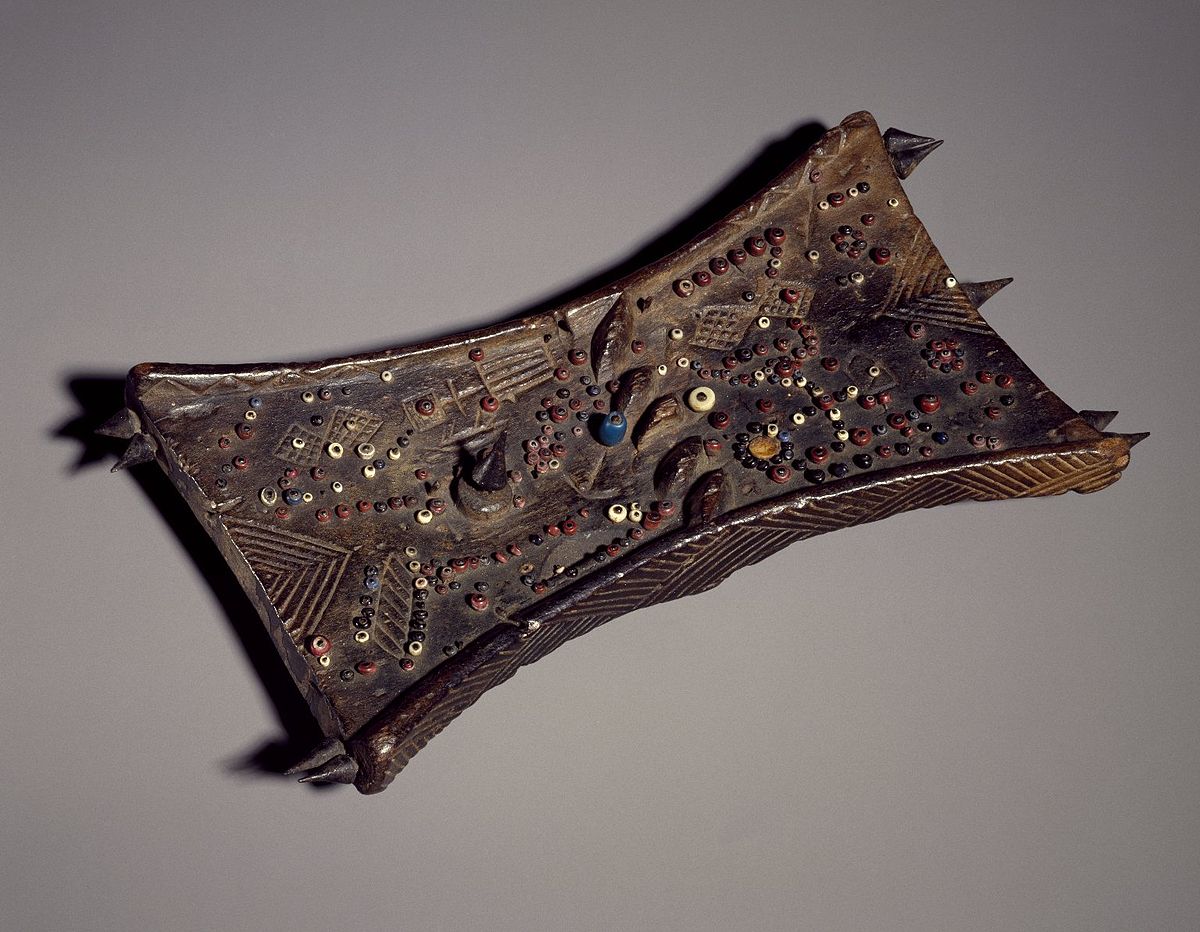
➼ Aka Elephant Mask
Details
Cameroon (western grasslands region)
c. 19th to 20th century
wood, woven raffia, cloth, and beads
Found in Brooklyn Museum, Brooklyn, New York
Form
The mask has the features of an elephant: long trunk, large ears (symbolizing strength and power).
The mask fits over the head and two folds hang down in front (symbolizing the trunk) and behind the body.
Human face.
Materials
Beadwork on a fabric backing; beadwork is a symbol of power.
Lavish use of colored beads and cowrie shells displays the wealth of the members of the men’s Kuosi society; the colors and patterns express the society’s cosmic and political functions.
Function
Elite Kuosi masking society owns and wears the masks; worn on important ceremonial occasions.
Only important people in society can own and wear an elephant mask.
Context
Performance art: maskers dance barefoot to a drum and gong; they wave spears and horsetails.
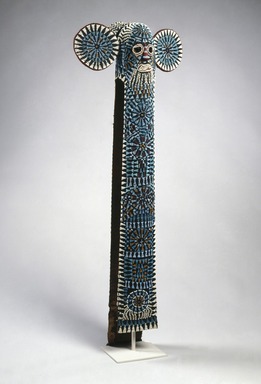
➼ Reliquary Figure (byeri)
Details
Fang peoples (southern Cameroon)
c. 19th to 20th century
Wood
Found in Brooklyn Museum, Brooklyn, New York
Form
Feet dangling over the rim, a gesture of protecting the contents.
Prominent belly button and genitals emphasize life; the prayerful gesture and somber look emphasize death.
Emphasis on the head and the tubular nature of the body.
Function
Such figures were placed on top of cylinder-like containers made of bark that held skulls and other bones of important clan leaders.
The reliquary figure guards the head box against the gaze of women or young boys.
Context
The surfaces were ritually rubbed with oils to add luster and protect against insects.
Byeri figures are composed of characteristics the Fang people place a high value on: tranquility, introspection, and vitality.
The Fang people were nomadic; these figures were made to be portable.
The abstraction of the human body is an attraction for the early-twentieth-century artists.
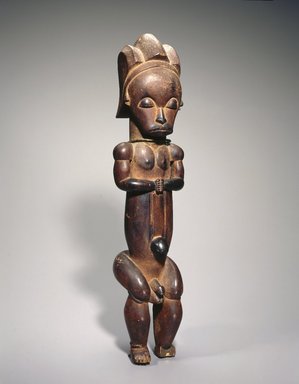
➼ Veranda Post of Enthroned King and Senior Wife (Opo Ogoga)
Details
Olowe of Ise (Yoruba peoples)
1910–1914
wood and pigment
Found in Art Institute of Chicago, Chicago, Illinois
Form
Wooden sculpture with tall vertical emphasis.
Complicated and elaborate use of negative space.
Negative space creates an openness in the composition.
Most veranda posts were painted; this work has traces of paint remaining.
Function
Olowe of Ise carved veranda posts for the rulers of the Ekiti-Yoruba kingdom in Nigeria.
One of four carved for the palace at Ikere, Nigeria.
Context
The king is the focal point between himself and others represented on the post.
Behind the king, his large-scale senior wife supports the throne.
She crowns the king during the coronation; protects him during his reign.
The smaller figures include his junior wife; his flute player, Eshu, the trickster god; and a figure of a fan bearer now missing.
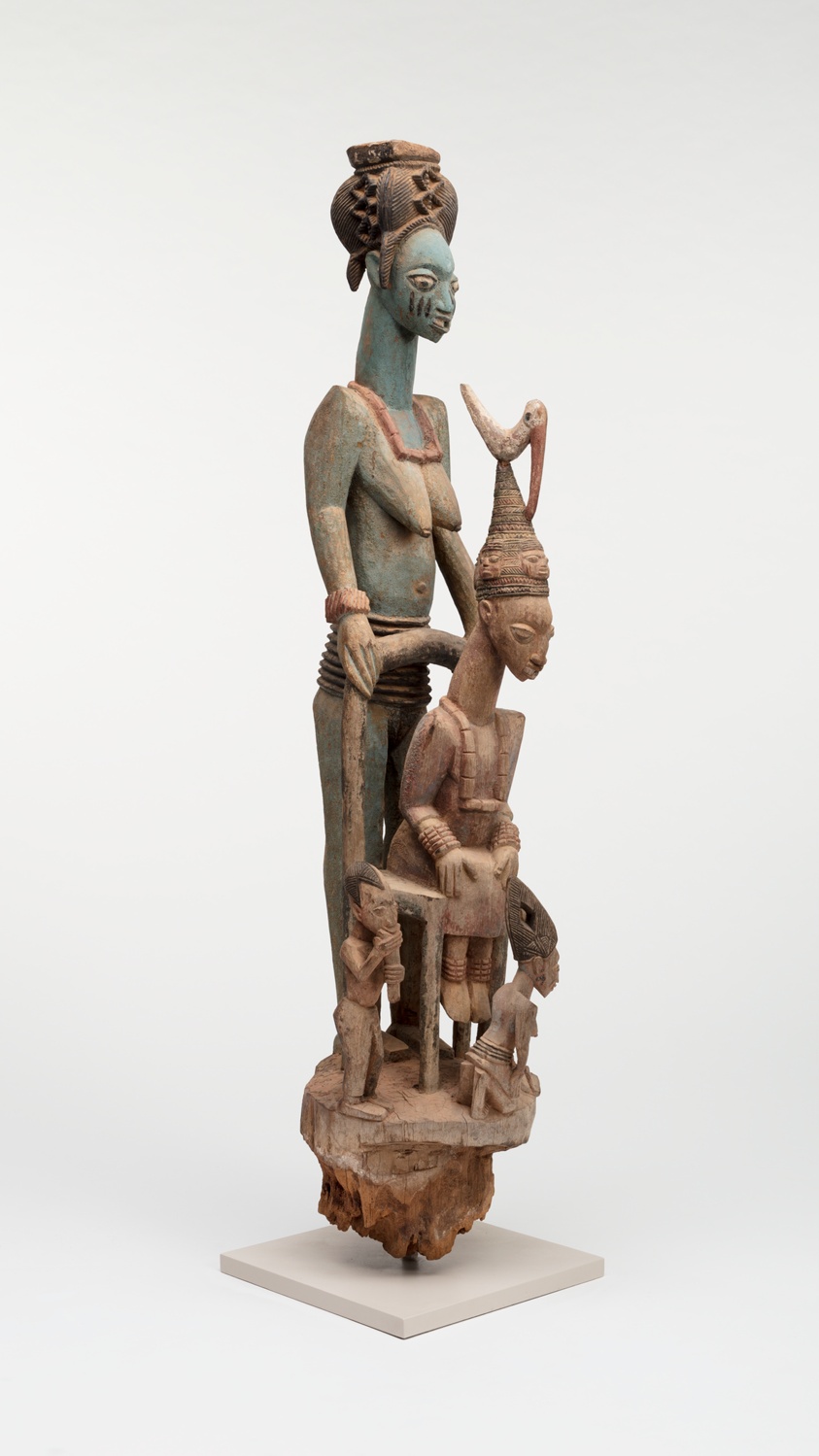
 Knowt
Knowt
